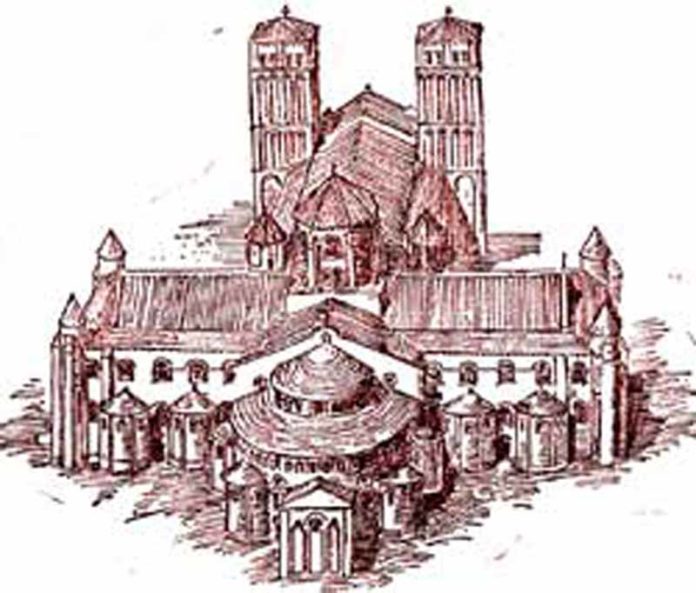A medieval monastery was viewed as a place of quiet contemplation, but was often home to dozens of men working in various capacities.
Whilst the main objective of a monastery was to house monks who prayed for the whole of medieval society, it was also a busy community, which tried to be as self-sufficient as possible.
The Monastic Church
The church was usually the first building to be constructed on a monastic site. This building was central to a monk’s life. Prayers took place in the church before dawn and services continued until Vespers in the evening.
European Christian churches were ideally aligned from east to west, with the choir window facing east towards the holy city of Jerusalem. This window would be the first to show the rays of the sun during the morning Vigil service.
The Cloister
The cloister is one of the best-known features of a monastery and was a central part of daily life. It was a covered walkway, which surrounded a central piece of garden. It was intended to allow monks to walk in contemplation, shaded from the sun or sheltered from the rain.
The Swiss monastery church of St Gall was the earliest to be built to a claustral plan and other European churches swiftly followed. Architectural innovations spread quickly across medieval Europe; monastic officers travelled the continent regularly on church business and were able to report back news of unusual and different buildings within weeks.
The Infirmary
The infirmary was similar to a hospital ward and was open to both monks and members of the public. Since the earliest days of Christianity, it had been the duty of men of God to provide physical and spiritual assistance to those who needed it.
The infirmarer was the monk in charge of the ward and the infirmary was one of the only places in the monastery where meat was served on a regular basis. An ordinary monastic diet included meat only on important feast days. However, it was believed that ailing people and those who had recently undergone blood-letting, needed meat to aid their recovery. The abbot was the only other monk allowed to eat meat on a regular basis, when entertaining guests at the monastery.
The infirmary was usually placed some distance from the other buildings, perhaps to remove the risk of infection to the rest of the community, or to allow the sick to recuperate free from noise and distraction.
The Chapter House
The chapter house was named for the chapters in the monastic rule and this was the large room where the monks gathered each day to hear one of the chapters from the monastic rule.
Talking was discouraged for most of the day and even meals were taken in silence.
The chapter house was one place where discussion was encouraged. Here, monks were allowed to discuss any problems within the community, such as an argument between two men or a problem with the upkeep of the buildings.
The Dormitory
Medieval monks slept communally in a dormitory, which was usually built above ground level. The dormitory in the majority of European monasteries was constructed as close as possible to the main church, to allow easy access to and from the church. Since the first office of the day began long before daylight hours, it was important that the monks could leave their beds and easily reach their place of prayer, even in darkness.
Other Buildings in a Medieval Monastery
Many of the other buildings which made up a monastic community were similar to those which could be found in a medieval town.
Typical monastic buildings would include a bakehouse, mill, laundry, workshop, guest house, brewery, granary, kitchen, library and scriptorium. The latter two were used in the production of medieval manuscripts, which, for most of the medieval period, were produced solely by monasteries.
The monastic ruins which have survived give only glimpses of what busy, thriving places the monasteries of Europe were.
Sources:
Burton, Janet Monastic and Religious Orders in Britain, 1000-1300, Cambridge, 1994
Lawrence, CH Medieval Monasticism: Forms of Religious Life in Western Europe in the Middle Ages, Longman, 2000








